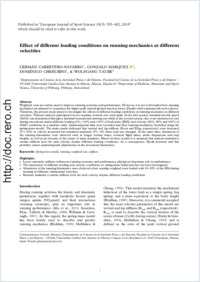Effect of different loading conditions on running mechanics at different velocities
- Carretero-Navarro, Germán Departamento de Ciencias de la Actividad Física y del Deporte, Facultad de Ciencias de la Actividad Física y del Deporte - UCAM, Universidad Católica San Antonio de Murcia, Murcia, España
- Márquez, Gonzalo Departamento de Ciencias de la Actividad Física y del Deporte, Facultad de Ciencias de la Actividad Física y del Deporte - UCAM, Universidad Católica San Antonio de Murcia, Murcia, España
- Cherubini, Doménico Departamento de Ciencias de la Actividad Física y del Deporte, Facultad de Ciencias de la Actividad Física y del Deporte - UCAM, Universidad Católica San Antonio de Murcia, Murcia, España
- Taube, Wolfgang Department of Medicine, Movement and Sports Science, University of Fribourg, Fribourg, Switzerland
-
28.05.2019
Published in:
- European Journal of Sport Science. - 2019, vol. 19, no. 5, p. 595–602
English
Weighted vests are widely used to improve running economy and performance. However, it is not well-studied how running mechanics are adapted to counteract the higher peak vertical ground reaction forces (Fpeak) while running with such a device. Therefore, the present study aimed to investigate the effects of different loading conditions on running mechanics at different velocities. Thirteen subjects participated in two separate sessions one week apart. In the first session, maximal aerobic speed (MAS) was determined through a maximal incremental running test while in the second session, they were instructed to run during one minute under different loading (0%, +10% and +20% of body mass [BM]) and velocity (60%, 80% and 100% of MAS) conditions in a random order. Spatiotemporal data were recorded and then running mechanics modelled using the spring-mass model. The main results indicated that vertical and leg stiffness (Kvert and Kleg, respectively) were increased (P < .001) as velocity increased but remained unaltered (P > .05) when load was changed. At the same time, alterations of the running kinematics were observed such as longer contact times, reduced flight times, stride frequencies and step lengths, as well as an increase of the centre of mass dynamics. Based on these results it is assumed that runners maintain a certain stiffness level for each velocity despite different loading conditions. As a consequence, Fpeak increases and this probably causes spatiotemporal adjustments in the movement kinematics.
- Faculty
- Faculté des sciences et de médecine
- Department
- Département de Médecine
- Language
-
- English
- Classification
- Sports sciences
- License
- License undefined
- Identifiers
-
- RERO DOC 326768
- DOI 10.1080/17461391.2018.1537378
- Persistent URL
- https://folia.unifr.ch/unifr/documents/308022
Statistics
Document views: 78
File downloads:
- tau_edl.pdf: 175
